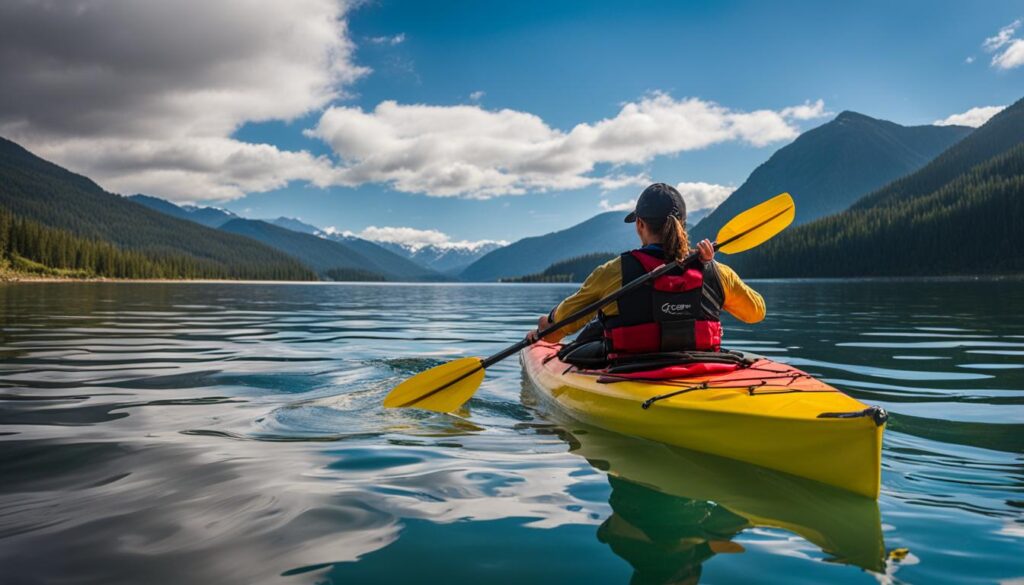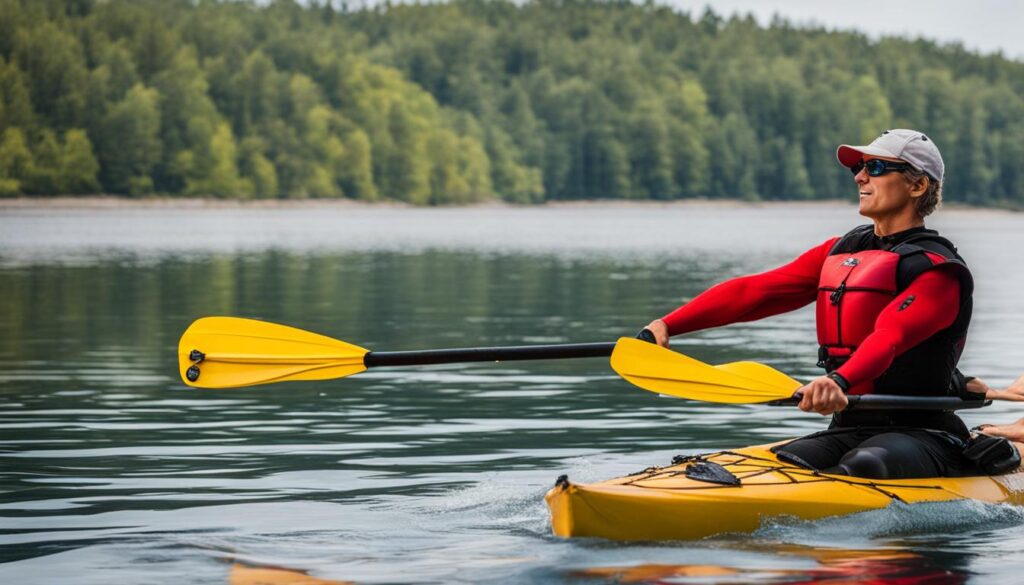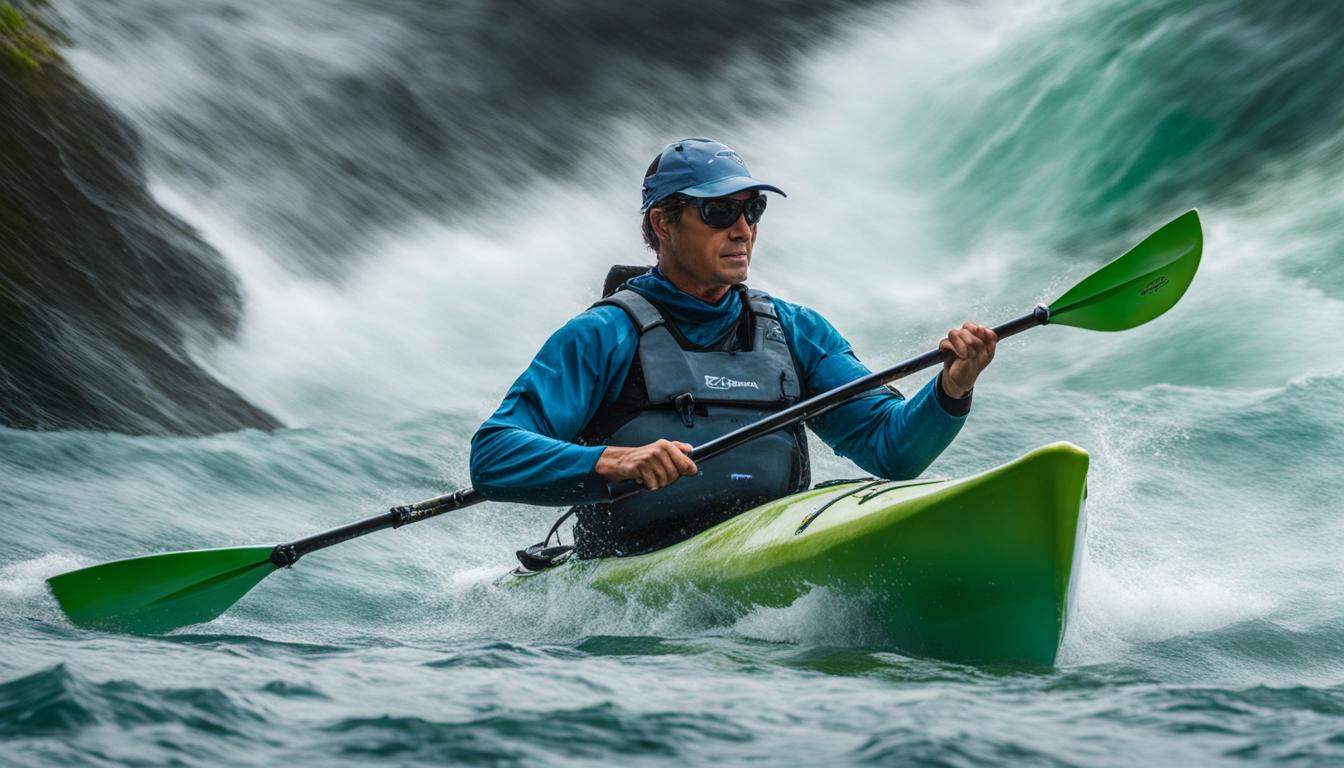Whether you are new to paddle sports or have been kayaking for years, it’s important to be mindful of potential shoulder injuries. Common injuries in kayaking include those to the shoulders, wrists, and lower back. To prevent these injuries, it is crucial to incorporate shoulder strength training exercises into your workout routine. By strengthening the muscles surrounding the shoulder joint, you can enhance shoulder stability and prevent overuse injuries.
Key Takeaways:
- Shoulder strength training is essential for preventing injuries in kayakers.
- By strengthening the muscles surrounding the shoulder joint, you can enhance shoulder stability.
- Incorporating targeted shoulder exercises into your training routine can improve performance and minimize the risk of overuse injuries.
- Consulting with a physical therapist or healthcare professional is recommended for personalized guidance and recommendations.
- Performing warm-up and cool-down exercises before and after kayaking sessions can help prevent injuries and maintain flexibility.
Importance of Shoulder Strength for Kayakers
When it comes to kayaking, having strong shoulders is crucial for both performance and injury prevention. The repetitive nature of paddling can put a lot of stress on the shoulder joint, making it more susceptible to injuries. By incorporating specific exercises that target the shoulder muscles into your training routine, you can build strength and stability, allowing you to paddle more efficiently and comfortably.
Exercises for paddling shoulder health, such as rotator cuff strengthening with resistance bands and bilateral external rotation, can help strengthen the muscles surrounding the shoulder joint. These exercises improve stability and endurance, minimizing the risk of overuse injuries. Additionally, exercises like single-arm bent-over rows and 90-degree lat pulldowns target the shoulder muscles, helping to build strength and prevent imbalances.
“Shoulder strength is crucial for kayakers to prevent injuries and enhance performance.”
In addition to specific shoulder exercises, it’s also important for paddlers to engage in activities that improve cardiovascular endurance. Swimming, rowing, or using cardio equipment at the gym are great options to consider. These activities not only improve overall fitness but also enhance performance in kayaking.
Building shoulder strength for kayaking is a continuous process. It’s essential to consult with a physical therapist or healthcare professional to ensure you are performing the exercises correctly and to address any specific issues or concerns you may have. They can provide personalized guidance and recommendations based on your individual needs and history, helping you to stay injury-free and perform at your best on the water.
Table: Sample Shoulder Strengthening Exercises
| Exercise | Description |
|---|---|
| Rotator cuff strengthening | Use resistance bands to perform exercises like internal and external rotations to strengthen the rotator cuff muscles. |
| Bilateral external rotation | Stand with arms bent and elbows at your sides, holding resistance bands. Rotate your arms outwards, keeping your elbows tucked in, to work the shoulder muscles. |
| Single-arm bent-over rows | Bend forward from the waist, supporting your body with one hand on a stable surface. Hold a weight in the other hand and pull it up towards your chest, squeezing your shoulder blades together. |
| 90-degree lat pulldowns | Using a lat pulldown machine, pull the bar down to your chest with your elbows at a 90-degree angle, engaging your shoulder muscles. |
Exercises to Strengthen the Shoulders
To prevent shoulder injuries and enhance your performance in kayaking, incorporating targeted shoulder training exercises into your workout routine is crucial. These exercises help improve shoulder stability, endurance, and overall strength. By focusing on the specific muscles used in paddling, you can develop the necessary strength to paddle efficiently and comfortably.
Here are some key exercises to strengthen the shoulders for kayaking:
- Rotator Cuff Strengthening with Resistance Bands: Attach a resistance band to a fixed object and hold the other end with your hand. Perform external and internal rotations, gradually increasing resistance as your strength improves.
- Bilateral External Rotation: Stand with your arms at your sides, elbows bent at 90 degrees, and a resistance band looped around both wrists. Rotate your forearms outward, feeling the tension in your shoulders.
- Horizontal Abduction: Lie on your stomach with your arms extended out to the sides. Lift your arms off the ground, focusing on squeezing your shoulder blades together.
- Single-Arm Bent-Over Rows: Hold a dumbbell or kettlebell in one hand and hinge forward at the hips. Perform a rowing motion by pulling the weight up towards your chest, keeping your elbow close to your body.
- 90-Degree Lat Pulldowns: Attach a resistance band to an overhead anchor point. Sit or stand facing the anchor point, arms bent at 90 degrees, and pull the band down towards your chest, engaging your lat muscles.
In addition to these exercises, it’s important to incorporate movements that improve standing balance, such as single-leg deadlifts and hip clock circles. These exercises help stabilize your core and improve overall balance in the kayak, reducing the risk of falls. Core strength exercises like wood chops, Palloff press, and side-lying planks with oblique twists can also enhance stability and prevent injuries. Remember to maintain proper form and gradually increase the intensity of your workouts to avoid strain or overexertion.

Table: Sample Shoulder Strength Training Routine
| Exercise | Sets | Repetitions | Rest |
|---|---|---|---|
| Rotator Cuff Strengthening with Resistance Bands | 3 | 12-15 | 30 seconds between sets |
| Bilateral External Rotation | 3 | 12-15 | 30 seconds between sets |
| Horizontal Abduction | 3 | 12-15 | 30 seconds between sets |
| Single-Arm Bent-Over Rows | 3 | 12-15 | 30 seconds between sets |
| 90-Degree Lat Pulldowns | 3 | 12-15 | 30 seconds between sets |
Remember to consult with a healthcare professional or physical therapist before starting any new exercise program, especially if you have a history of shoulder injuries. They can provide personalized guidance and ensure that you are performing the exercises correctly and safely.
Warm-up and Cool-down Exercises for Kayakers
Before diving into an exhilarating kayaking adventure, it’s essential to take a few moments to properly warm up your muscles and joints. A dynamic warm-up routine can help prime your body for the physical demands of kayaking, reducing the risk of injury and enhancing your performance on the water.
The Importance of Priming Muscles and Joints
Priming your muscles and joints before kayaking is crucial as it increases blood flow to the working muscles, improves joint lubrication, and prepares your body for the specific movements involved in paddling. A dynamic warm-up routine involves performing exercises that mimic the motions of kayaking and gradually increase your heart rate.
A great warm-up exercise is standing overhead side bends with a paddle. Hold the paddle overhead with both hands and gently bend your torso from side to side, engaging your core and stretching the muscles of your sides. This exercise helps to activate your obliques and warm up the muscles involved in rotating your torso during kayaking.
Another effective warm-up exercise is standing trunk twists with a paddle. Hold the paddle across your chest with both hands and rotate your upper body from side to side, keeping your lower body stable. This exercise helps to loosen up the muscles of your back, shoulders, and core, preparing them for the rotational movements required during paddling.
Cooling Down and Stretching
After a satisfying kayaking session, it’s important to cool down and stretch to help prevent post-workout stiffness and maintain flexibility. Stretching can help elongate your muscles, improve circulation, and promote recovery.
Performing static stretches can be beneficial after kayaking. Try incorporating hip flexor stretches, hamstring stretches, and internal rotator stretches into your cooldown routine. These stretches target the muscles that are commonly tight after kayaking, including the hip flexors, hamstrings, and muscles of the rotator cuff, helping to alleviate tension and maintain flexibility in these areas.
Remember to hold each stretch for 15 to 30 seconds and breathe deeply throughout. Stretching should never be painful; if you experience any discomfort, ease off the stretch.
| Warm-up Exercises | Benefits |
|---|---|
| Standing overhead side bends with a paddle | Activates obliques and warms up muscles involved in torso rotation |
| Standing trunk twists with a paddle | Loosens up back, shoulder, and core muscles |
| Cool-down Stretches | Benefits |
|---|---|
| Hip flexor stretches | Lengthens tight hip flexor muscles |
| Hamstring stretches | Improves flexibility in the hamstrings |
| Internal rotator stretches | Increases flexibility in the rotator cuff muscles |
Incorporating dynamic warm-up exercises and cool-down stretches into your kayaking routine can help you not only prevent injuries but also optimize your performance on the water. By priming your muscles and joints and maintaining flexibility, you’ll be able to enjoy your kayaking adventures with reduced risk of discomfort and improved overall fitness.

Additional Tips and Recommendations
Strengthening your shoulder muscles is crucial for paddlers to prevent injuries and enhance performance in kayaking. In addition to specific shoulder exercises, there are a few additional tips and recommendations that can help you stay strong, prevent reinjury, and optimize your kayaking experience.
1. Incorporate Cross-Training Activities
To further enhance your shoulder strength and overall fitness, consider incorporating cross-training activities into your routine. Engaging in activities like swimming, rowing, or using cardio equipment at the gym can improve your cardiovascular endurance and complement your kayaking workouts. These activities work different muscle groups and provide variations in movement patterns, helping to prevent muscle imbalances and reduce the risk of overuse injuries.
2. Focus on Proper Technique
Proper technique is essential for kayakers to avoid unnecessary strain on the shoulder joint. Make sure to receive proper instruction and guidance on paddling technique to ensure that you are using your shoulders, arms, and core muscles efficiently. This will not only improve your performance but also minimize the risk of injury. Consider working with a qualified instructor or joining a paddling club to learn and refine your technique.
3. Listen to your Body
Pay close attention to your body and listen to any warning signs or pain signals. If you experience any discomfort or pain in your shoulders while kayaking, it is important to address it promptly. Take the time to rest and recover, and consult with a physical therapist or healthcare professional if needed. They can provide guidance on appropriate modifications, exercise progressions, and treatments to help you safely continue your kayaking journey.
By incorporating these additional tips and recommendations into your kayaking routine, you can strengthen your shoulder muscles, enhance performance, and prevent reinjury. Remember to always prioritize your safety and well-being by listening to your body and seeking professional guidance when necessary. Enjoy paddling with confidence and strength, knowing that you are taking proactive steps to protect your shoulders and optimize your kayaking experience.
Conclusion
Shoulder strength is crucial for kayakers to prevent injuries and enhance performance. By incorporating targeted shoulder exercises into your training routine, you can strengthen the muscles surrounding the shoulder joint, improve stability, and prevent overuse injuries.
It is also important to perform warm-up and cool-down exercises to prime your muscles and joints and maintain flexibility. Before starting any kayaking session, consider a dynamic warm-up routine that includes exercises to increase blood flow and mimic the movements required during kayaking.
Remember to consult with a physical therapist or healthcare professional for personalized guidance and recommendations based on your specific needs and history. They can provide expert advice on proper training techniques and help create an individualized plan of care to address any specific concerns.
With proper shoulder strength training, you can enjoy paddling with reduced risk of injury and improved performance on the water. So, don’t forget to prioritize your shoulder health and incorporate these exercises into your routine for a safer and more enjoyable kayaking experience.
FAQ
Why is shoulder strength important for kayakers?
Shoulder strength is crucial for paddlers to maintain proper form and technique, improve performance, and prevent injuries. It enhances shoulder stability and prevents overuse injuries caused by the repetitive nature of kayaking.
What exercises can I do to strengthen my shoulders for kayaking?
Some key exercises include rotator cuff strengthening with resistance bands, bilateral external rotation, horizontal abduction, single-arm bent-over rows, and 90-degree lat pulldowns. Standing balance exercises like single-leg deadlifts and hip clock circles can also improve stability. Core strength exercises like wood chops, Palloff press, and side-lying planks with oblique twists can enhance stability as well.
Should I warm up before kayaking?
Yes, it’s important to prime your muscles and joints before kayaking to prevent injuries. A dynamic warm-up routine is recommended, including exercises that increase blood flow, lubricate the joints, and mimic kayaking movements. Examples include standing overhead side bends with a paddle and standing trunk twists with a paddle.
Are there any cool-down exercises I should do after kayaking?
Yes, cooling down and stretching after kayaking is important to elongate muscles and prevent stiffness. Performing static stretches such as hip flexor stretches, hamstring stretches, and internal rotator stretches can help maintain flexibility.
What other activities can I do to improve my kayaking performance?
Engaging in activities that improve cardiovascular endurance, such as swimming, rowing, or using cardio equipment at the gym, can enhance your overall fitness and performance in kayaking.
Should I consult with a professional before starting kayaking or paddling activities?
It is recommended to consult with a physical therapist or healthcare professional before starting any kayaking or paddling activities, especially if you have a history of shoulder injuries. They can provide guidance on proper training techniques, assess your injury risk, and create an individualized plan to address your specific needs and concerns.





